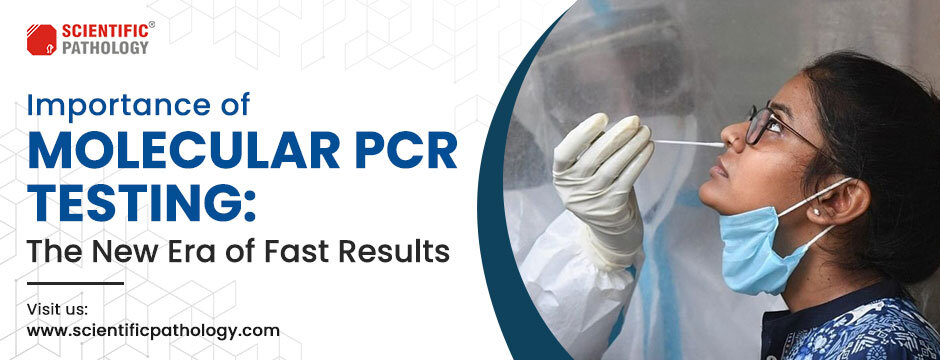Importance of Molecular PCR Testing: The New Era of Fast Results
Tests performed on blood or tissue samples to identify disorders, evaluate the effectiveness of cutting-edge or time-tested therapies, and keep track of health are collectively referred to as "in vitro diagnostics" (IVD). IVDs are being used in new precision medicine techniques to identify individuals who would likely benefit from a particular treatment.
In general, IVDs may be categorized as tests for organs-on-chip, chemical, microbiological, and immunological systems. Chemical IVDs are essentially medical devices that use specific biochemical reactions to detect proteins or metabolites, such as at-home glucose, Hemoglobin, or cholesterol testing kits. In contrast to immunological IVDs, which use highly specific antibody-antigen interactions to detect proteins or metabolites, such as ELISAs, RIAs, and lateral flow assays.
Molecular IVDs
Recently, molecular IVDs have expanded beyond the detection of infectious agents to a variety of biomedical fields, including Oncology, Hematology, Genetics, Clinical Chemistry, And Patient-Tailored Precision Medicine interventions. This is in addition to the surge of molecular diagnostics in point-of-care (POC) tests brought on by the COVID-19 pandemic. Although nucleic acid-based tests can identify infectious agents sooner and with great sensitivity, antibody-based ELISA tests continue to be the gold standard for verifying the presence of infections. Reverse transcription isothermal amplification, multiplex quantitative PCR, and reverse transcription PCR are all recognized as the best confirming assays for finding viral RNA. The market for molecular diagnostics, which is now projected to be worth $89 billion, is anticipated to increase to $118 billion by 2027.
Constellation of PCR-based techniques
All PCR techniques use primers or brief synthetic single-stranded oligonucleotide fragments of complementary DNA that bind to templates to amplify defined sequences millions or billions of times during subsequent rounds of denaturation, annealing, and polymerase chain reaction (PCR). Although there are many different-nuanced methods that rely on PCR, such as digital-, inverse-, amplified fragment length polymorphism (AFLP)-, end-point- The thermal cycler, a standard piece of equipment in virtually every laboratory, cycles the temperature periodically to start each stage.
While classical end-point PCR may determine if a certain DNA sequence is present or absent, its output is only qualitative. The approach produces semi-quantitative findings when the quantity of the end-point product is compared to that of a housekeeping or control gene.
Quantitative PCR, which is used to genotype single nucleotide polymorphisms (SNPs) or copy number variations (CNVs), diagnose infections, and track the effectiveness of treatments, demonstrates the rise in nucleic acid amplification over time. The starting material for quantitative reverse transcription PCR (RT-qPCR) is RNA, which is then translated by a reverse transcriptase enzyme into complementary DNA (cDNA). Thereafter, q PCR is used to amp up the cDNA template. A specific thermocycler is needed for real-time quantitative PCR, which employs fluorescent reporter molecules that produce more light as the amount of amplified DNA product increases.
What are the uses of molecular testing?
Identification of genetic variants is the main objective of molecular diagnostics in order to streamline detection, diagnosis, classification, prognosis, and therapy response. Modern molecular methods are frequently utilized by medical professionals and clinicians to:
- Examine the dangers of certain illnesses,
- Confirm the presence of illnesses that are difficult to detect in lab settings,
- Develop and confirm treatment plans by assisting patients, especially those who are pregnant or wanting to become pregnant,
- Analyze the efficacy of a continuing course of therapy and the probable reactions of patients to medicines.
- Detect specific diseases or subtypes, such as ovarian or breast cancer.
The Importance
Success stories for the use of molecular diagnostics in low-income environments go well beyond COVID-19. In the past ten years, hemorrhagic viruses that were unexpectedly present in Nigeria were quickly identified using molecular techniques, weeks before more conventional reference techniques could be used. In both cases, the early insights offered by the on-the-spot molecular PCR Testing gave the public health response direction.
At hospitals in the Gambia, culture followed by whole-genome sequencing (WGS) allowed for the simultaneous identification of the unique etiologic agents of newborn sepsis, determination of their antibiotic resistance profiles, and localization of nosocomial outbreaks5. As demonstrated by the evaluation of archival samples from Bangladesh6, which tripled the conventional sensitivity and retrospectively revealed a Chikungunya virus epidemic, molecular techniques can boost pathogen identification in patients with meningitis by many orders of magnitude. These and several additional instances support the widespread use of molecular diagnostics despite some minor but manageable difficulties.
The current molecular diagnostics promises are just the tip of the iceberg; thus it's important to remove the barriers to their wider adoption. Stronger mechanisms for procurement, shipping and handling, stock management, and waste disposal need to be implemented in place of the emergency responses inspired by the pandemic that are used to address supply chain issues that afflict low-income nation health systems and laboratories. Solar backup systems have been deployed in many laboratories recently to combat frequent power outages.
Benefits
Faster Results: Using PCR Kits, findings may be delivered to clinicians in a reasonable amount of time.
Shorter Time to Optimal Therapy: Clinical professionals can decide on treatments more rapidly with faster outcomes.
Improve Treatment Decisions: Clinical professionals can enhance the efficacy of therapy by providing prompt responses on comprehensive panels.
Avoid Unnecessary Antibiotics: Clinical professionals are less inclined to recommend empiric treatment when they have quick diagnostic results.
Reduce Unnecessary Testing: Rapid responses might also lessen the need for later testing. They lessen the need for exams like ultrasounds, X-rays, CT scans, and endoscopies.
Economic effects may also result from the clinical and procedural advantages of using the PCR Panels for testing. There are several opportunities for possible cost reductions, including less antibiotic usage, shorter hospital stays, and fewer diagnostic testing.
The low-resource but fastest-growing diagnostic environments of the coming decade will include "smart" equipment that can effortlessly continue after a power outage. Future-proof technology that is now available for some applications (such Oxford nanopore sequencers) will only need sporadic power supply. Other industries outside biomedicine must also come up with innovative solutions to address infrastructural and supply chain gaps. National public health institutions, which have previously demonstrated leadership in several situations, are best positioned to offer the much-needed governance, coordination, and support for the spread of public health diagnostics.




